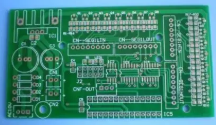At present, there are two types of semi-aqueous cleaning equipment: online cleaning machine and batch cleaning machine. The online cleaning mainly adopts the spraying method, which conveys a large number of circuit board assemblies, which is suitable for high-volume printed board assembly units. The batch cleaning machine adopts ultrasonic, centrifugal and jetting methods, its output is small, and it is suitable for use in printed circuit board assembly plants with medium and low output.
The semi-aqueous cleaning uses different cleaning agents, which leads to the diversity of this process. Therefore, the corresponding equipment should be used for different semi-aqueous cleaning processes. No matter what kind of process equipment requires some kind of mechanical excitation, the purpose is to strengthen the mutual contact and collision between the semi-aqueous cleaning solvent and the printed board to make the cleaning more effective. The four measures used to strengthen cleaning are: spray, flow in the solvent tank, pressurized spray under immersion liquid, and ultrasonic.
The semi-aqueous cleaning process has the following points to pay attention to:
1. For flammable solvents, there must be corresponding protective measures (such as nitrogen environment protection) when used in spray mode.
2. Wastewater treatment should be considered, and the drying step should be reliable.

3. For some solvents that have harmful odors or are volatile substances, measures such as ventilation should be strengthened.
4. The resistivity of the rinse water must meet the requirements of the product, generally from 100K to 1 trillion, and the requirements for special products are higher.
2.3 Semi-aqueous cleaning process
The semi-aqueous cleaning process is: solvent or emulsifier cleaning (additional spray, ultrasonic) - water rinsing (two passes) - hot air drying
Auxiliary equipment includes pure water preparation, wastewater treatment, etc.
3 Water cleaning
3.1 Features of water cleaning
Water cleaning methods can be divided into the following two categories:
(1) The water-based cleaning method of adding saponifier and surfactant to pure water can clean rosin flux, oil stains, ion pollution, etc.
(2) Pure water cleaning that uses pure water to clean water-soluble solder and flux.
The cleaning features are as follows:
(1) Good safety
(2) The formula has a large degree of freedom in composition, a wide cleaning range, and a good cleaning effect on polar and non-polar pollutants.
(3) Low price and easy access to raw materials
(4) The washing effect is better when ultrasonic waves are allowed.
3.2 Water cleaning process equipment and precautions
The water cleaning process equipment is mainly composed of three types of equipment: pure water production, cleaning, and wastewater treatment.
Water cleaning equipment is divided into the following three categories: batch-type water cleaning equipment, which completes the steps of cleaning, rinsing, and drying in a cleaning room, suitable for small and medium-sized batches, multi-variety, and small-batch production; multi-tank cleaning equipment, generally has four Each tank completes the steps of cleaning, rinsing, and drying. Generally, there is an additional drying box to complete the final drying task, which can be manually operated or mechanically transported; on-line multi-slot cleaning machine, PCB board is transported by adjustable speed large mesh conveyor belt, There are generally four washing areas inside the whole machine, consisting of two air knives and hot air drying areas, and has a water heating function to complete the pre-washing, rinsing, air cutting, and drying processes. The online multi-slot cleaning machine can be combined with the previous wave soldering and reflow soldering to form an on-line cleaning, and it can also be used as an independent unit to clean the printed boards that have been manually repaired.
Since electronic equipment is very sensitive to ion pollution, the requirements for cleaning water are very high. The specific requirements are:
(1) Demineralized water can be used for pre-washing and cleaning, or a cleaning solution can be prepared with demineralized water;
(2) Use deionized water for rinsing;
(3) The grade of deionized water should be selected according to the requirements of the product; in general, pure water with a resistivity of 50K~100K can be used, and products with higher quality performance requirements and surface coating should be selected from 1 trillion to 18 trillion. Pure water.
Purified water equipment uses tap water as raw material to produce water, which generally includes coarse filtration, fine filtration, and deionization devices. The deionization devices are divided into three methods: electrodialysis, ion exchange resin, and reverse osmosis. The specific use depends on the quality and Design the scheme based on the level of water resistivity required by the user.
If cleaning wastewater does not meet the national discharge standards, it must be discharged after sewage treatment reaches the standards. If the wastewater can be recycled and reused after sewage treatment, it will not cause pollution to the environment. Sewage treatment equipment should be designed according to the pollutant composition of sewage, and generally include the following functions: filtration or precipitation of particulate matter, removal of oily pollution, chemical precipitation of metal ions, and neutralization.
Since water is used as the main material for cleaning, the following points must be paid attention to during use:
(1) The water quality must meet the standards, and no new pollution should be introduced during the cleaning process due to water quality problems.
(2) Drying must be sufficient, otherwise it will affect the future PCB storage and protective coating.
(3) For different fluxes and solders, saponified water washing or pure water washing can be selected.
(4) Since water washing is not as tolerant as solvent washing, the corresponding requirements for process control are stricter, such as water temperature, pressure, belt speed, saponifier content, etc. should be considered comprehensively. At the same time, the cleaning effect is also related to the assembly density of the printed board.